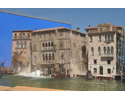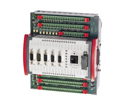
Box office figures have confirmed that the most recent James Bond film 'Casino Royale' has been one of the most successful in this ever-popular franchise. Although the film steers clear of some of the more traditional gadgets that 'Q' can muster up; it still has a breathtaking array of special effects scenes.
One of the biggest, the sinking of a Venetian building, was a unique motion control challenge that involved Moog and its partner EMP Designs Ltd. Moog's role was to ensure the smooth and safe operation of a huge rig that had to sink one of three motion bases, the largest weighing 80,000 kg (176,370 lbs), into the large water tanks at Pinewood Studios just outside London.
The sinking building was part of one of the final scenes in the film and required two different camera angles — an external scale model shot against a blue screen to show the building sinking into one of the Venetian canals and a full-scale internal model used to film the actors inside the actual sinking building. The structures themselves, developed under the auspices of special effects supervisor Chris Courbould, had to be controlled with extreme precision so carefully choreographed stunts and action sequences could be filmed. Courbould and his special effects team built the structures and then called in Dan Stanton and his team from EMP Designs, to develop the control systems.

The equipment designed to control the rig centred on an M3000 system, which for this application can be split into the hardware — Moog Servo Controller (MSC); and software — Moog Axis Control Software (MACS). It was used to control six digital Moog Axis Control Valves (ACV), which, in turn operated six hydraulic actuators.
Feedback of the actuator position was achieved using a number of wire-driven encoders supplied by the partner company. The digital nature of all of the hardware was a major selling point according to Dan Stanton at EMP Designs who states,"With respect to the hydraulic control, we have worked with other companies in the past, but we wanted to do something special this time. Moog was the only company that could supply what we wanted — a hydraulic system based on digital valve technology".
Mr. Stanton continues, "The digital approach offered us finer control and it also gave us more confidence when it came to the safety aspects as, if anything were to get disconnected or the control was lost, we knew about it as it gets detected immediately. Much of the actuation was also performed in synchronized pairs so digital also gave us far greater control in this respect. Another vital consideration was the amount of radio frequency that exists on film sets, and given the long cable lengths digital is far more resilient so we were less prone to external influences in the control and feedback loops."
In the application the MSC controller used a CAN link to connect to six Axis Control Valves each of which controlled a cylinder — working in pairs, this gave three axes of motion. The Axis Control Valves then used a CANOpen link to connect to the BTF encoders, which produce a unique digital code for every 0.025 mm (0.00098 in) of travel — providing the precise feedback required for cylinder position. The Axis Control Valves provided remote closed-loop position control for each degree of motion. This reduced the processing load on the MSC allowing it to take care of the safety monitoring and synchronization. The MSC provided all the profile generation for the ACVs over the CAN Bus. "This was a new approach for us but the Moog M3000 offered us a stable, flexible control structure and cost-effective solution for what we were trying to achieve," continues Stanton. "It also offered the capability for us to integrate a 38.1 cm (15 in) touch screen (HMI), which gave us a complete simplistic overview of the system using MACS (Moog Axis Control Software) — which, as well as offering us clear visualizations, allowed us to pinpoint the source of any erroneous readings.
"One important aspect of the software was that it allowed the system to self diagnose," Stanton explains. "We were able to create routines that would highlight any discrepancies or anomalies. This was the first time we had ever used a controller that helped us make the decision of whether to press the 'big red stop button'; if anything deviated it was able to assess the severity and then make a decision based on this figure — it took a lot of the worry out of it for us. The controller also incorporated a 'Watchdog' which reverted to a safe state should any issues arise with the controller."
"There are some very big movies in production at the moment which are also using this technology," Stanton continues. "Indeed there has been significant interest from the movie world with many production companies expressing an interest in what we can do with this digital system. The flexibility of the M3000 system is that it is also designed for electro-mechanical actuation, this allows us to look at other types of film effects including smaller scale animations using small DC motors; once again it is the software that pays dividends. We also have to consider the fact that movie concepts can change over night so flexibility is vital — this is another benefit the digital approach gives us."
Author
Rebecca Gunn is the UK Industrial Sales and Marketing Co-ordinator, based in Tewkesbury. Employed since August 2006, Rebecca is responsible for marketing communications in the UK. Previously self-employed for 5 years supporting UK businesses manufacturing technology associated with learning and development, and prior to that, working 5 years for the McGraw-Hill group as a marketing co-ordinator for their former UK based elearning business. Rebecca is a CIM (Chartered Institute of Marketing) qualified marketer.
About EMP
EMP Designs Ltd is a design consultancy specializing in projects involving Electronic, Pneumatic, Hydraulic and Mechanical systems. This includes multi-axis closed loop positional systems either servo driven or hydraulic for any scale from needle positioning to 80 ton platform control, PLC driven industrial control, programmable sequence controllers, electronic project/test boards, encrypted radio communication and controls and opto-electronic displays.
In the film industry EMP has designed solutions for camera crews, model makers and special effects teams on many high-profile movies such as 'Casino Royale'.
EMP also has in-house machining facilities which enable them to make accurate components, design and manufacture printed circuit boards, and design and build a variety of product housings to complete a project.
Further information can be obtained from www.empdesigns.co.uk or email Dan Stanton.

